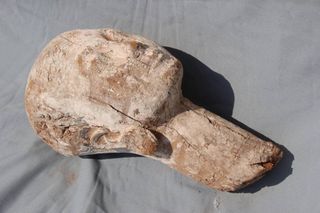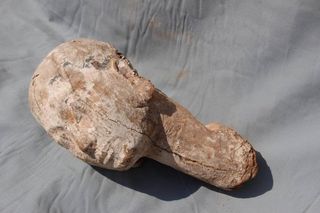Statue of Egyptian Queen Unearthed Near Giza Pyramids

More than 4,000 years ago, ancient Egyptian artisans carved the likeness of a queen into a wooden statue and even bejeweled her highness with wooden earrings, according to a new discovery announced today (Oct. 18) by Egypt’s antiquities ministry.
The newly discovered wooden head likely portrays the sixth-dynasty ruler, Queen Ankhnespepy II (also spelled Ankhesenpepi II), the ministry said.
The life-size, 12-inch-tall (30 centimeters)wooden head was found in a disturbed layer of Earth near the queen's temple in the Saqqara necropolis by a French and Swiss archaeology team from the University of Geneva. [Photos: 2,000-Year-Old Tombs Found in Egyptian Oasis]
Ankhnespepy II has a storied history. She was born a commoner, but then her elder sister, Ankhenespepi I, married Pharaoh Pepi I. The two had a son named Merenre, Egyptologist Vivienne Callender wrote in a 2012 report for The Encyclopedia of Ancient History.
Then, the younger sister, Ankhnespepy II, married the Pharaoh Pepi I. After Pharaoh Pepi I died in about 2350 B.C., the queen acted as a regent for her 6-year-old son, Pepi II, until he came of age, Callender said. Moreover, Ankhnespepy II married her nephew Merenre, a marriage that scholars consider to be "unique in Egyptian history," Callender wrote. Ankhnespepy II and her nephew had a daughter who was also named Ankhenespepi.

Given that Ankhnespepy II wasn't born a royal, it's astounding that "she was one of the most influential queens in Egyptian history," Callender wrote in the report.
Earlier this week, archaeologists found a pyramidion — a capstone for an obelisk — in the same area where they found the wooden head, which is about an hour's drive south of the Great Pyramid of Giza, Philippe Collombert, the head of the French-Swiss archaeology team and an Egyptologist at the University of Geneva, told the Egypt Ministry of Antiquities. The pyramidion was made out of pink granite, and may belong to the queen's funerary temple, Collombert said.
Sign up for the Live Science daily newsletter now
Get the world’s most fascinating discoveries delivered straight to your inbox.
"It is a promising area that could reveal more of its secrets soon," Mostafa Waziri, the secretary-general of the Supreme Council of Antiquities in Egypt, said in a statement. The archaeologists plan to continue their excavations, with the goal of finding other pyramids built for the queen and the associated funerary complex and artifacts, Waziri said.
Original article on Live Science.

Laura is the archaeology and Life's Little Mysteries editor at Live Science. She also reports on general science, including paleontology. Her work has appeared in The New York Times, Scholastic, Popular Science and Spectrum, a site on autism research. She has won multiple awards from the Society of Professional Journalists and the Washington Newspaper Publishers Association for her reporting at a weekly newspaper near Seattle. Laura holds a bachelor's degree in English literature and psychology from Washington University in St. Louis and a master's degree in science writing from NYU.

